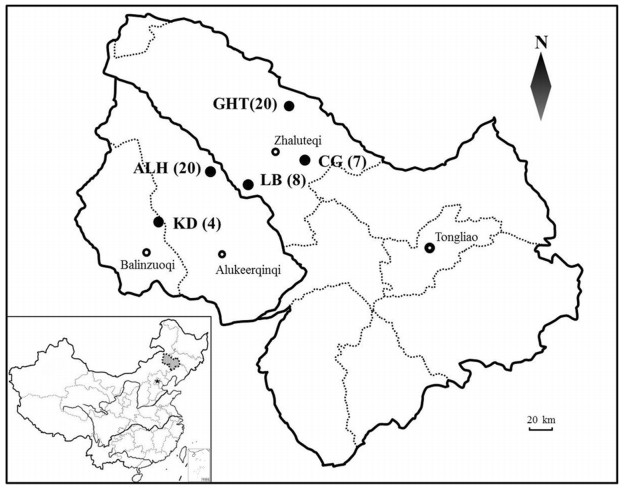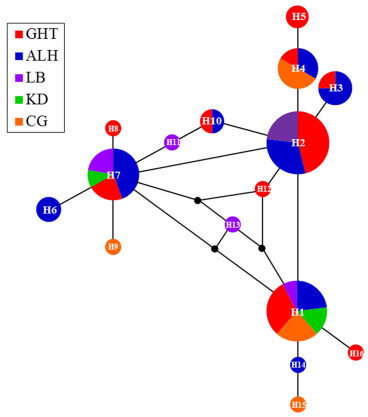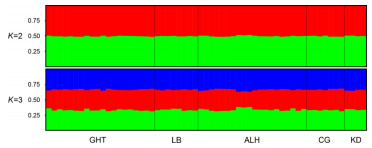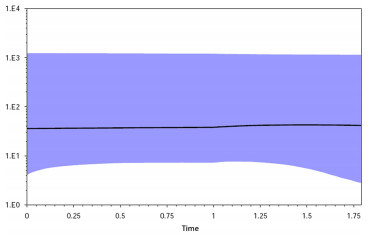
Phylogenetic tree of E. jankowskii recovered by maximum likelihood analysis. Bootstrap support and posterior probabilities are shown only for nodes highly supported by at least two phylogenetic reconstruction methods (i.e., ≥ 60% maximum likelihood, maximum parsimony or neighbor-joining bootstrap support or ≥ 0.60 Bayesian posterior probability). Outgroups (obtained from GenBank) are indicated by their species names. Colored squares represent different populations. Details of the populations are given in the text
Figures of the Article
-
![]() Geographical distribution of Emberiza jankowskii in Inner Mongolia, China. Black dots represent sampling sites. Black circles indicate cities. The numbers of individuals sampled are given in parentheses
Geographical distribution of Emberiza jankowskii in Inner Mongolia, China. Black dots represent sampling sites. Black circles indicate cities. The numbers of individuals sampled are given in parentheses
-
![]() Phylogenetic tree of E. jankowskii recovered by maximum likelihood analysis. Bootstrap support and posterior probabilities are shown only for nodes highly supported by at least two phylogenetic reconstruction methods (i.e., ≥ 60% maximum likelihood, maximum parsimony or neighbor-joining bootstrap support or ≥ 0.60 Bayesian posterior probability). Outgroups (obtained from GenBank) are indicated by their species names. Colored squares represent different populations. Details of the populations are given in the text
Phylogenetic tree of E. jankowskii recovered by maximum likelihood analysis. Bootstrap support and posterior probabilities are shown only for nodes highly supported by at least two phylogenetic reconstruction methods (i.e., ≥ 60% maximum likelihood, maximum parsimony or neighbor-joining bootstrap support or ≥ 0.60 Bayesian posterior probability). Outgroups (obtained from GenBank) are indicated by their species names. Colored squares represent different populations. Details of the populations are given in the text
-
![]() Median-joining network of 16 mtDNA haplotypes of E. jankowskii. In the network, different colors represent different populations
Median-joining network of 16 mtDNA haplotypes of E. jankowskii. In the network, different colors represent different populations
-
![]() Structure clustering of E. jankowskii individuals based on microsatellite genotypes. Clusters are shown for K = 2 and K = 3. Population acronyms are shown on the X-axis. Details of the populations are given in the text
Structure clustering of E. jankowskii individuals based on microsatellite genotypes. Clusters are shown for K = 2 and K = 3. Population acronyms are shown on the X-axis. Details of the populations are given in the text
-
![]() Historical demography of E. jankowskii inferred from mtDNA D-loop sequences. Bayesian skyline plots for E. jankowskii in Inner Mongolia, showing effective population size as a function of time. The upper and lower limits of light blue trend represent the 95% confidence intervals of HPD analysis
Historical demography of E. jankowskii inferred from mtDNA D-loop sequences. Bayesian skyline plots for E. jankowskii in Inner Mongolia, showing effective population size as a function of time. The upper and lower limits of light blue trend represent the 95% confidence intervals of HPD analysis
Related articles
-
2024, 15(1): 100154. DOI: 10.1016/j.avrs.2023.100154
-
2023, 14(1): 100122. DOI: 10.1016/j.avrs.2023.100122
-
2023, 14(1): 100112. DOI: 10.1016/j.avrs.2023.100112
-
2022, 13(1): 100016. DOI: 10.1016/j.avrs.2022.100016
-
2021, 12(1): 47. DOI: 10.1186/s40657-021-00283-4
-
2020, 11(1): 34. DOI: 10.1186/s40657-020-00220-x
-
The role of climate factors in geographic variation in body mass and wing length in a passerine bird2017, 8(1): 1. DOI: 10.1186/s40657-016-0059-9
-
2014, 5(1): 8. DOI: 10.1186/s40657-014-0008-4
-
2013, 4(1): 93-98. DOI: 10.5122/cbirds.2013.0006
-
2012, 3(4): 302-311. DOI: 10.5122/cbirds.2012.0034


 Download:
Download:









 Email Alerts
Email Alerts RSS Feeds
RSS Feeds